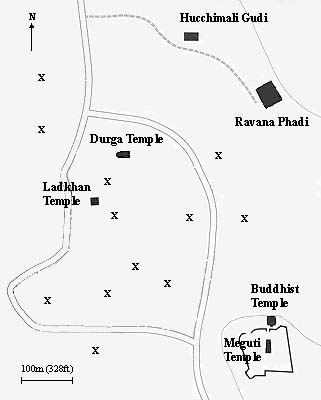
Aihole
Durga Temple
(13),
Hucchimalli Gudi
(5),
Lad Khan Temple
(7),
Meguti Jain Temple
(1),
Ravana Phadi cave temple
(7),
Suryanarayana temple
(1),
Two-story Buddhist temple
(1)

|
AiholeDurga Temple
(13),
|
The village of Aihole (pronunciation: eye-HO-lee) contains over 125 temples from the Early Western Chalukya and later periods (6th - 12th century). Shown here, and on the following pages, are some Early Chalukya examples from the 6th - 8th centuries. The locations of a few other temples are marked with bold x's on the map, just to give an idea of the richness of the site.
The architecture of Early Western Chalukya reflects diverse influences from neighboring areas. For example, as the Blue Guide (p. 331) explains, curved towers decorated with blind arches are found in central and western India; pilastered walls with panel inserts are a southern Indian style; while the Deccan style includes balcony seating, angled eaves and sloping roofs, and elaborately carved columns and ceilings. Readers can find, in the following pages, many examples of mixed styles, often on the same temple. For example, in the Suryanarayana temple, the left hall is Dravidian (s. India); the middle hall is Rashtrakutan; and the tower is Deccan.
By way of showing the unity within this diversity, Huntington (p.337) identifies some typical features of Early Western Chalukyan architecture. These include mortarless assembly, an emphasis on length rather than width or height, flat roofs, richly carved ceilings, and sculpturally, an emphasis on relatively few major figures, that tend to be isolated from each other rather than arranged in crowded groups.
Aihole is located near Badami in the state of Karnataka. The names of the temples are based on recent usage, and do not reflect their original dedications.

|